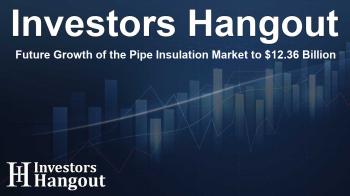Future Growth of the Pipe Insulation Market to $12.36 Billion

Overview of the Pipe Insulation Market
The Pipe Insulation Market is witnessing significant growth as industries increasingly prioritize energy efficiency and environmental sustainability. A recent report indicates that the market, valued at USD 7.7 billion in 2024, is anticipated to soar to USD 12.36 billion by the end of the forecast period. This growth is projected at a compound annual growth rate (CAGR) of 5.80% from 2026 to 2032.
Key Growth Drivers in the Market
As industries worldwide evolve, there’s a strong emphasis on optimizing energy conservation and regulatory compliance. Pipe insulation plays a crucial role in minimizing heat loss and maintaining temperature control in various applications such as oil & gas, chemical processing, HVAC systems, and construction.
Energy Efficiency and Operational Cost Reduction
The global push for energy efficiency is forcing companies to evaluate their operations critically. Pipe insulation significantly reduces energy wastage, which is monumental in industries like food processing and pharmaceuticals where maintaining thermal stability is essential. It allows businesses to save on energy costs, thereby extending equipment lifespan and minimizing maintenance expenses.
Expansion in Oil & Gas Sector
The oil and gas industry remains a primary consumer of pipe insulation, essential for maintaining thermal control of pipelines transporting various fluids. With rising global energy demand, substantial investments in midstream and refining infrastructure create a robust market. Pipe insulation provides safety and compliance while minimizing the risk of corrosion and ensuring durability.
Market Challenges
Despite the promising growth, the market faces several challenges. One key issue is the volatility in raw material prices, particularly for petroleum-based insulation materials, which are subject to fluctuations due to broader market dynamics.
Supply Chain Disruptions
Post-pandemic, supply chain challenges have only intensified, leading to inconsistent raw material availability. Such disruptions can create difficulties in maintaining steady production levels and can squeeze profit margins for manufacturers.
Awareness in Developing Markets
While there is a strong understanding of insulation benefits in developed regions, awareness is limited in developing areas. Without strict regulations or incentives for energy-efficient construction, many new infrastructure projects lack adequate insulation, leading to long-term inefficiencies.
Regional Market Insights
The Pipe Insulation Market's dynamics vary across different regions, with North America currently holding a dominant position. The maturation of its industrial infrastructure and rigorous energy efficiency regulations support sustained demand for insulation solutions.
Emerging Economies
In contrast, regions like Asia-Pacific are experiencing rapid growth attributed to urbanization and increased infrastructure spending. Governments are promoting energy-efficient buildings, which has become a significant driver for the adoption of insulation materials.
Leading Companies in the Industry
Several key players are shaping the landscape of the global pipe insulation market. Companies such as Owens Corning, Kingspan Group, and Rockwool International A/S are at the forefront, consistently innovating to meet the evolving needs of the market.
Competitive Landscape
These companies focus on advanced insulation technologies and materials to enhance performance and sustainability. They invest in research and development to foster innovative solutions that address both current and future industry challenges.
Conclusion
The future of the Pipe Insulation Market looks promising, with a clear trajectory towards substantial growth driven by energy efficiency trends and rising construction activities. As companies adapt to regulatory changes and consumer preferences, investments in insulation technologies are expected to rise significantly.
Frequently Asked Questions
What is driving the growth of the Pipe Insulation Market?
Key drivers include increasing energy efficiency demands, expansions in oil & gas infrastructure, and a surge in construction activities in developing regions.
What challenges does the Pipe Insulation Market face?
The market faces challenges such as raw material price volatility, supply chain disruptions, and limited market awareness in developing economies.
Which regions are showing growth in the Pipe Insulation Market?
While North America leads in market share, the Asia-Pacific region is emerging rapidly due to urbanization and initiatives promoting energy-efficient building practices.
Who are the key players in the Pipe Insulation Market?
Significant players include Owens Corning, Kingspan Group, Rockwool International A/S, and ARMACELL, who are continually innovating in insulation solutions.
How does pipe insulation contribute to energy savings?
By minimizing heat loss and gain, pipe insulation helps maintain consistent temperatures, significantly reducing energy consumption and costs in industrial processes.
About The Author
Contact Thomas Cooper privately here. Or send an email with ATTN: Thomas Cooper as the subject to contact@investorshangout.com.
About Investors Hangout
Investors Hangout is a leading online stock forum for financial discussion and learning, offering a wide range of free tools and resources. It draws in traders of all levels, who exchange market knowledge, investigate trading tactics, and keep an eye on industry developments in real time. Featuring financial articles, stock message boards, quotes, charts, company profiles, and live news updates. Through cooperative learning and a wealth of informational resources, it helps users from novices creating their first portfolios to experts honing their techniques. Join Investors Hangout today: https://investorshangout.com/
The content of this article is based on factual, publicly available information and does not represent legal, financial, or investment advice. Investors Hangout does not offer financial advice, and the author is not a licensed financial advisor. Consult a qualified advisor before making any financial or investment decisions based on this article. This article should not be considered advice to purchase, sell, or hold any securities or other investments. If any of the material provided here is inaccurate, please contact us for corrections.

